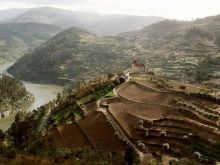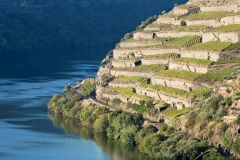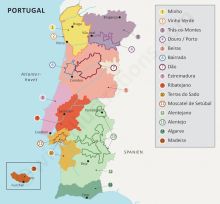For most American wine lovers Portuguese wine means Port, the rich fortified Portugal wine made in the hot, dry Douro Valley in the northern part of the country. But the past decade has witnessed a greater flow of high-quality table wines.



that seldom exceeded $15 on American retail shelves. Most wines from Portugal's Dão region, together with Alentejo, the country's deepest source for quality red Portuguese wines outside the Douro, were under $10 until recently and still seldom exceed $20, even those from the top producers. Today's most interesting wines rely almost exclusively on indigenous grapes or on those of Iberian origin, such as Alvarinho (Albariño in Spain) and Tinta Roriz (Tempranillo in Spain).
The Distinctive Red Grapes of Portugal
Baga: This highly distinctive variety dominates in the Bairrada region of north-central Portugal, where it produces high-acid, slow-to-evolve Portuguese wines with moderate alcohol but substantial tannins from thick skins. Some examples show a rather exotic grapefruit quality. There have been efforts recently to tame the more brutal qualities of the grape through destemming and shorter, less extractive vinification. Baga is sometimes blended into Dão and Ribatejo wines to give them more backbone.
Castelão: Also called Periquita, especially in the southern half of the country, where the grape is widely planted. The Portugal wine it produces is usually lush and fruity, providing wines that can be enjoyed young. The best examples come from Ribatejo, northeast of Lisbon, and on the Setúbal Peninsula east of the capital. Castelão has been described as Merlot to Baga's Cabernet, although in Ribatejo it can also produce firmer wines.
Tinta Barroca: Planted throughout the Douro, where it is one of the main components in port, this large-berried variety produces deeply colored but often somewhat rustic wines with generous alcohol levels. Tinta Barroca is often used to add softness and floral character to port blends.
Tinta Roriz: This is Portugal's Tempranillo, producing wines that are fragrant and complex, with good color, body, backbone, and resistance to oxidation despite possessing only moderate acidity. The second most widely planted variety in the Douro, this grape is increasingly popular as a stand-alone variety for dry red Portuguese wines. (Tinta Roriz is called Aragonez in Alentejo, where the wines it produces are softer and more liqueur-like.)
Touriga Franca: Limited mostly to the Douro, where it's the most widely planted variety (and often called by its former name Touriga Francesa), this grape is a key ingredient in most Portugal ports owing to the fleshiness of texture it imparts. This relatively thick-skinned grape has a tendency to overproduction, and sugar levels are generally moderate to low.
Touriga Nacional: The heart of port, and the Douro region's -- if not the country's -- most complete and most fashionable red grape, even if it still accounts for only a small percentage of production in the Douro. The wine produced from this low-yielding variety, characterized by thick skins and small berries, is deeply colored and concentrated, with excellent tannic and acid spine but also a seductive floral character. Touriga Nacional is also the backbone for most reds from Dão, where it may have originated.
Trincadeira Preta: One of the most widely planted red grapes in Portugal, and at its best in the hot, dry Alentejo, where it produces deeply colored, spicy wines with good body. Trincadeira Preta is known as Tinta Amarela in the Douro.
White grapes of Portugal
Alvarinho:Grown almost exclusively along the Minho River in the north end of the Vinho Verde region, Alvarinho produces aromatic Portuguese wines with more alcoholic body and concentration than most other white grapes in this cool area. It's an important element in many Vinhos Verdes and is increasingly bottled on its own.
Arinto:This high-acid variety is responsible for some of the freshest, most fragrant wines of Bucelas, Estremadura, and Alentejo. (In the cooler Vinho Verde region, where it's called Pedernão, it's usually too tart.) These wines of Portugal are characterized by steely and minerally nuances and brisk citrus fruits.
Bical:Widely planted in Bairrada and Dão, this is another white variety that's coming back into favor and increasingly being bottled on its own. Bical can produce weighty yet fragrant wines with enough acidity to develop gracefully in bottle, becoming more minerally and petrolly (as in Riesling) with age.
Encruzado:This grape, which has long been planted in the Dão region, is being brought back from near-extinction by a handful of producers who are convinced that its sound balance of sugars and acids should enable it to produce complete, full-bodied wines of Portugal on its own. These Portuguese wines show a tendency toward exotic, tropical fruits, and are increasingly being fermented and aged in small barrels.
Loureiro:Widely planted in the north, this grape, along with Trajadura, is an important component in many Vinho Verde bottlings. Common characteristics of the variety are high yields and subtle floral and herbal notes.
Trajadura: A base variety for most Vinho Verde, this grape has lower acidity but higher potential alcohol than the other important varieties used to make these wines. Not surprisingly, this early-ripening, very productive grape adds body to Vinho Verde.
Portugal’s wines have four primary designations:
1.DOC - Quality Wine Produced in a Specific Region (QWPSR or VQPRD, these are the most protected wines and indicates a specific vineyard, such as Port Wine, Vinhos Verdes, and Alentejo Wines. These wines are labeled D.O.C. (Denominação de Origem Controlada) which secures a superior quality.
2. IPR - Wines that have more regulations placed upon them but are not in a DOC region fall under the category of Indicação de Proveniência Regulamentada (Indication of Regulated Provenance)
3. Vinho Regional Regional Wine - Carries with it a specific region within Portugal.
4. Vinho de Mesa -Table Wines - carries with it only the producer and the designation that it's from Portugal.(Source: Wikepedia, Food and Wine's Wine Guide 2012)
